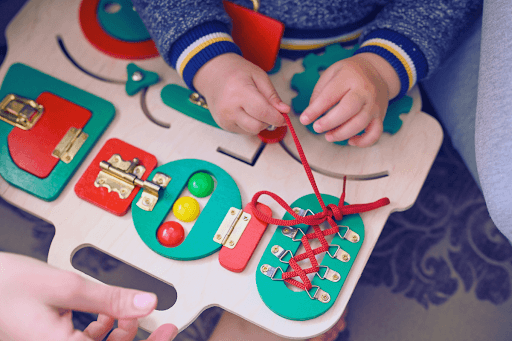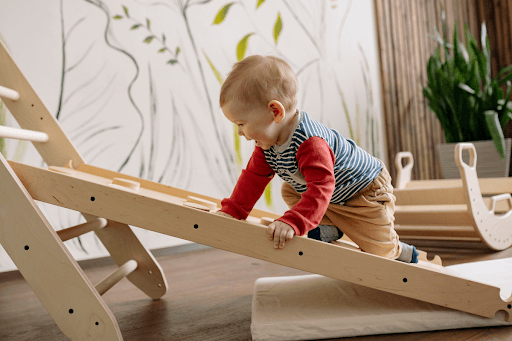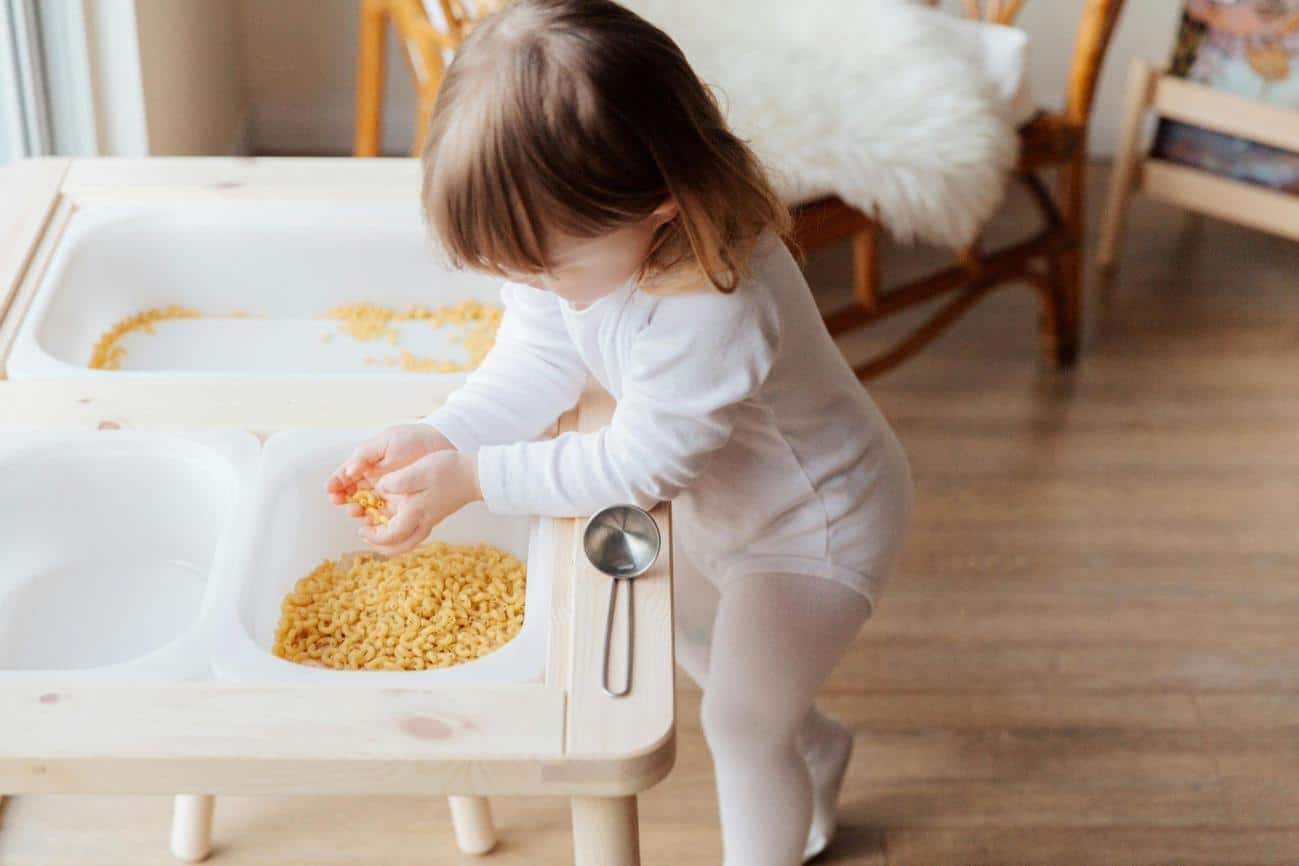
Fine Motor Skills vs. Gross Motor Skills
From your child’s first scribbly crayon artwork to their weekend soccer game, understanding the roles of fine motor skills versus gross motor skills can make all the difference in nurturing their developmental journey. Let’s explore your child’s milestones and activities offered in the Shichida program to foster these skills.
Table of Contents
Fine Motor Skills vs. Gross Motor Skills: A Snapshot
Let’s take a quick look at the key differences before we explore each skill set in more depth.

What are Fine Motor skills for Kids?
Fine motor skills focus on the movement of small muscles, mainly in your little one’s hands, fingers, and wrists.
These skills are incredibly important because they serve as the building blocks for many everyday tasks that your child does.
This includes foundational milestones like writing their name with a crayon, buttoning up their shirt, or using utensils at mealtime—activities that may seem straightforward to adults but are significant stepping stones in a child’s developmental journey.
Your child will also rely on fine motor skills for other essential and fulfilling milestones. Like the day they manage to tie their shoelaces unassisted or when they correctly hold a pencil to sketch a picture.
Each of these tasks contributes to their growing sense of independence and self-reliance.
Fine motor skills also allow kids to express themselves creatively, whether in academics, sports, or the arts.
Fine Motor Developmental Milestones
These milestones are signs of growing independence and markers of your child’s fine motor skills becoming more refined.
Kids develop at their own pace, so consider these milestones as general guidelines rather than strict timelines.
- 6 months: Your little one starts bringing toys to their mouth— a fine motor skill in the making!
- 9 months: Watch as your baby starts using a pincer grasp to pick up small objects— it’s a key to fine motor development.
- 12 months: Putting toys in containers and taking them out again is a sign of emerging fine motor skills.
- 18 months: If your toddler is starting to scribble or attempting to use a spoon, these are encouraging steps in fine motor development.
- 2 years: Stacking four or more blocks and following simple two-step instructions are good indicators of advancing fine motor skills.
- 3 years: Turning the pages of a book one at a time and maneuvering buttons are more refined fine motor skills to look out for.
- 4 years: Your child may start using scissors or drawing basic shapes—these are notable fine motor achievements.
- 5 years: Being able to draw more detailed figures and writing some letters indicates solid progress in fine motor skills development.
Why are Fine Motor Skills for Kids Important?
When it comes to your child’s growth, fine motor skills might not be the first thing that comes to mind. However, fine motor skills are closely related to mental development.
Starting to nurture these skills early in your child’s life can offer benefits beyond the fun of playing with toys.
Here’s why fine motor skill development should be fostered from infancy:
School-Ready Skills
Early stacking, scribbling, and other fine motor activities set the stage for the more complex tasks your kiddo will tackle in school.
Boosting Hand-Eye Coordination
Activities like gripping toys improve hand-eye coordination, a helpful skill in everyday life and future sports or musical activities.
Building Confidence and Independence
Mastering fine motor skills, like buttoning a shirt, boosts your child’s self-confidence and fosters independence.
Activities to Boost Fine Motor Skills
The Shichida Australia program teaches fine and gross motor skills across our baby and toddler classes.
Enhancing a baby’s finger dexterity paves the way for mastering essential life skills, such as self-feeding, drawing, writing, and much more.
Proficiency can accelerate rapidly when a child is given ample opportunities to explore objects and engage in hands-on activities.
In our toddler classes, examples of fine motor skill activities include picking up small objects with their fingers, drawing, and learning to create controlled lines—whether they’re straight, wavy, spirals, or zig zags.
We also teach skills such as buttoning, using utensils in imaginative play, tying knots, and developing precision in manipulating small objects with tweezers and chopsticks.
Additional activities include cutting, glueing, folding origami, and opening and closing small containers.
For older kids in our kinder classes, we build on these foundations by introducing writing, advanced drawing techniques accompanied by drawing songs, as well as cutting and folding complex shapes that include 3D objects and intricate origami designs.
Fine motor skill activities to try at home:
For Younger Kids:
Pick up small objects: Strengthens finger grip, which is important for handwriting.
Drawing lines: Helps improve control over hand and finger movements.
Buttoning: Aids in hand-eye coordination and fosters independence in dressing.
Using utensils in play: Prepares them for actual mealtime.
Cutting and glueing: Develops hand control for detailed tasks.
Folding origami: Enhances attention to detail and control.
For Older Kids:
Writing: Refines hand control for better handwriting.
Cutting complex shapes: Improves spatial understanding and manual dexterity.
Advanced origami: Takes their folding skills to the next level, requiring more precision.
Each of these activities targets specific fine motor skills that will benefit your child in daily activities and academic tasks.
Incorporating them into your child’s routine can provide a strong foundation for their ongoing development.
What are Gross Motor Skills?
Gross motor skills refer to the abilities usually acquired during childhood and are essential for performing everyday activities.
They involve the larger, stronger muscle groups used for tasks like running, jumping, and balancing.
Essentially, they are the skills that get your kids from point A to point B.

Why are Gross Motor Skills for Kids Important?
A Foundation for Physical Fitness
Good gross motor skills form the basis of a healthy, active lifestyle. Children who develop these skills are more likely to engage in sports, dance, and other physical activity.
Building Coordination and Balance
These skills also contribute to your child’s balance and coordination. This means not only better athletic abilities but also fewer bumps and tumbles.
Social Interaction and Teamwork
Many gross motor activities are also social activities. Think of a toddler playgroup or a team sport. These activities help kids learn how to work together and build social skills.
Gross Motor Developmental Milestones
As with fine motor skills, tracking your child’s developmental milestones in gross motor abilities is important.
Typical gross motor developmental milestones:
- Six months: Your baby starts to roll over, an early sign of gross motor development.
- Nine months: Sitting without support and crawling are significant milestones in your baby’s gross motor skills.
- Twelve months: Your child begins to stand well, marking the start of more complex gross motor activities.
- Eighteen months: Walking alone and ascending stairs show your toddler is progressing in gross motor development.
- Two years: Kicking a ball and standing on tiptoes signal improved bodily control.
- Three years: Running smoothly and climbing stairs one foot per step indicate advanced gross motor skills.
- Four years: Hopping on one foot and being able to stand on one foot for two seconds are signs of further refinement in gross motor abilities.
- Five years: The ability to stand on one foot for 10 seconds indicates a strong foundation in gross motor skills.
Why It’s Important to Nurture Gross Motor Skills from an Early Age
Here’s why nurturing gross motor skills early is crucial for your child’s overall growth:
Fun and play: Gross motor skills enable children to enjoy games that also enhance social skills.
Future athletes: Skills like running and catching objects set the stage for possible future athletic endeavours.
Everyday independence: Gross motor skills are vital for daily tasks like walking to school or climbing stairs.
How we Support Gross Motor Skills in the Shichida Australia Program
We send home targeted exercise suggestions tailored to your child’s age and developmental stage to do at home. These fun, simple activities target specific muscle groups essential for optimal gross motor development.
While fine and gross motor skills serve different functions, they are both crucial for your child’s development.
By understanding their importance and incorporating activities that foster these skills, you’re setting the stage for your child’s future success in both academic and everyday life.
Would you like to see your child thrive? Discover more about what we teach or book a trial class at one of our early childhood learning centre’s today.


